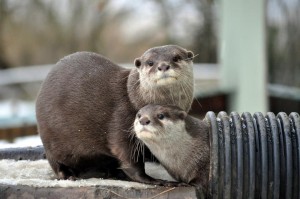Besottered! When Musa met Mimi...
Musa the otter has met his love match!

Our resident Asian short-clawed otter has fallen head over paws for an 18-month-old female brought in from the Wildfowl & Wetlands Trust’s site in London, as part of plans to start a breeding programme.
The lucky lady has been named Mimi, thanks to competition winner Marilyn Elliott, from Sunderland.
Animal manager Owen Joiner, who was responsible for overseeing the happy couple’s introduction, said: “Within a few days of her arrival, it was clear that Musa had found true love with his pretty new partner.
“They are very affectionate towards one another and she follows him around the enclosure in such a doting way.
“Asian short-clawed otters are a vulnerable species on the IUCN Red List and are part of an ongoing WWT conservation breeding programme.
“Musa and Mimi have been ‘getting to know’ each other very well since she moved in, to the point where she can often be spotted yawning because she’s so tired, so we've got high hopes for the patter of tiny furry paws soon!”
Until last December, three-year-old Musa had been living at the award-winning WWT Washington alongside his brother Rod, who has now set up home in London with Mimi’s sister.
The siblings – born at WWT Martin Mere in Lancashire on 3 October 2009 – were firm favourites with visitors, entertaining the crowds with their cheeky antics as they swam, played with pebbles and rolled around in the mud.
Mimi was born at Chessington World of Adventures on 20 July 2011 and, along with her three sisters, moved to WWT London, in Barnes, as part of a family group. Musa is the offspring of a Blue Reef Aquarium and Cornish Seal Sanctuary pairing.
Visitors can meet the happy pair during daily commentated feeds at 11.30am and 3pm (included in admission).
Did you know?
- Otters are part of the mustelid family, which translates as ‘smelly animal’.
- Asian short-clawed otters are the smallest of all 13 otter species.
- They are a vulnerable species on the IUCN Red List.
- They are found in southern India, southern China, south-east Asia, Indonesia and the Philippines.
- The main threats to their survival are habitat destruction and direct persecution from hunting and trapping.
- They are one of the few sociable otters and often play games, helping their young to develop hunting skills.
- They communicate through at least 12 different calls.
- Pairs can have two litters of up to six young per year and gestation is about 60 days.



